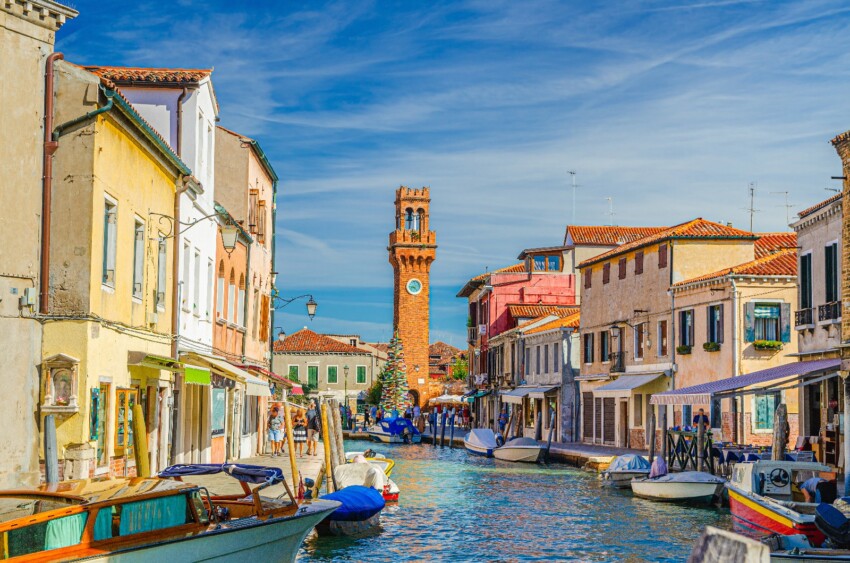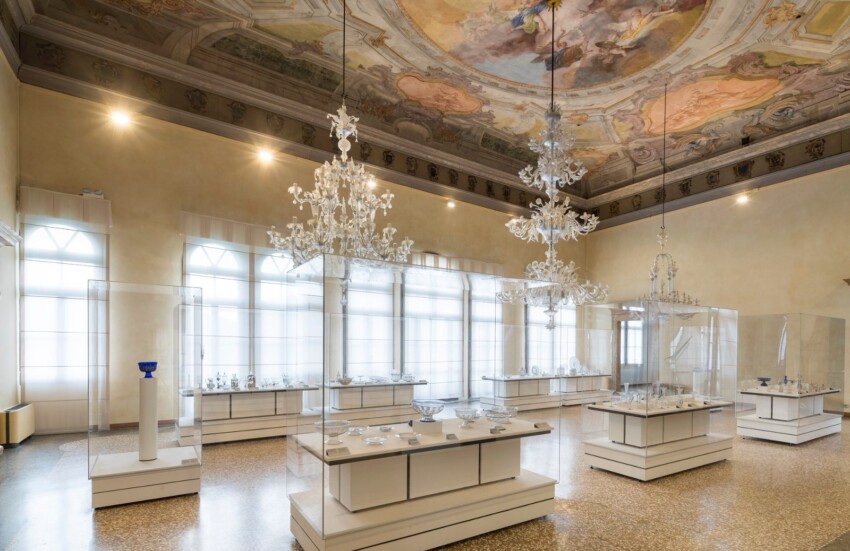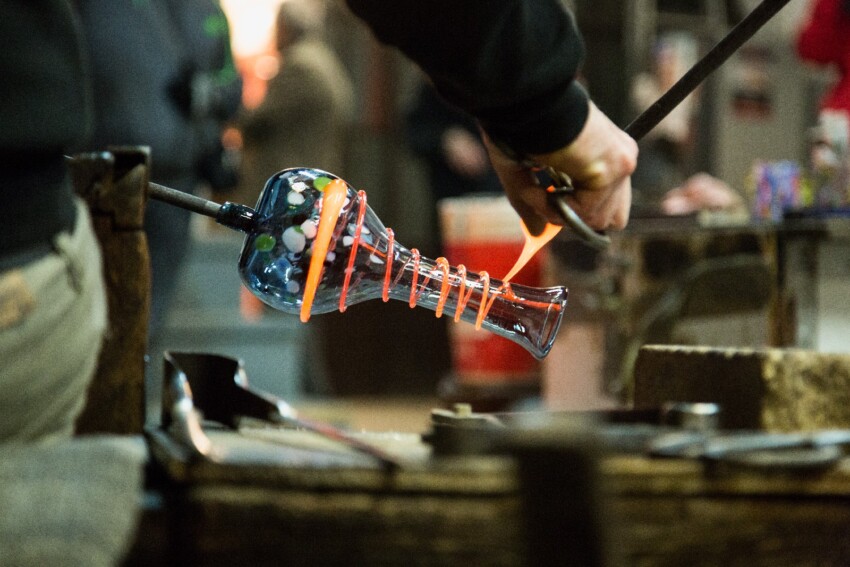
A visit to Murano is the ideal appendix to a perfect Venice holiday. Only a couple of vaporetto stops away from the historic centre with its carousel of overcrowded calli and kitsch souvenirs, the island of Murano manages to surprise all visitors despite being considered a must-see in Venice.
It is the largest island in the lagoon (if you exclude the centre of Venice), itself made up of seven islands connected by bridges and crossed by a main canal (called, needless to say, Canal Grande) overlooked by low houses with colourful facades and elegant palazzi. You get around on foot, and even here you can get lost among the campi and campielli, up and down the bridges, hunting for the perfect view for a breathtaking photograph or a romantic sunset over the lagoon.
Murano’s fame is inextricably linked to glass, a ‘humble’ raw material that the mastery of local craftsmen has elevated to the status of an artistic creation.
Witnessing the elaborate process by which blown glass takes on the most incredible shapes – an animal, a vase, a ball, a chandelier and countless others – is an exciting and unrepeatable experience. Where else in the world can you experience magic made only of sand, fire, air and craftsmanship? You cannot miss a visit to the glass workshops during your holiday in Venice!
Glasswork is a living tradition, carried out by companies with important customers all over the world, and not a mise en scene for the use and consumption of tourists. And this, after all, is Murano’s real charm: being a real city with 30,000 inhabitants, vital and authentic, and not an open-air museum.
It can be visited as a stop on a boat tour of the Venetian islands or chosen as a base for a special stay in Venice, at a slow pace, far from the hustle and bustle of the more touristy areas.
It is worth leaving the centre of Venice to reach Murano because the things to see on this island are truly unique.

Murano’s top attraction is undoubtedly the Glass Museum, an institution created in 1861, just after the darkest period in the history of Murano glass, with the aim of enhancing this typically Venetian art and restoring it to its splendour.
Commissioned by the then mayor of Murano Antonio Colleoni and Abbot Vincenzo Zanetti, it was conceived as an archive of documents that could bear witness to the history and life on the island; thanks to generous donations from local glassworks, it became a museum open to the public.
A visit to the museum is a journey through seven hundred years of Murano glass history: the tour is chronological, starting from the 14th century and arriving up to the present day.
On display you will find the greatest masterpieces of glass art from all historical periods; in addition to admiring these extraordinary creations, you will learn how glass is worked, what the different techniques are, what the golden and dark periods of this activity that combines craftsmanship, creativity, fashion and design were.
The museum is housed in an elegant Venetian Gothic palace that was once the residence of the bishops of Torcello.
The second obligatory stop on any trip to Murano is a visit to a glass workshop: after learning about the history of this Made in Italy excellence, one cannot help but want to see for oneself how the elaborate artefacts on display at the museum are made.
Almost all Murano glassworks are open to visitors. Guided tours generally begin with an explanation of the production process and the blowing technique, after which you move on to the furnace where a craftsman shows how a blown glass object is made. The tour ends in the company outlet, where those interested can purchase jewellery, sculptures, chandeliers and murrine at a discount.
Those who want to go beyond a simple visit can participate in courses and workshops in glass modelling and jewellery making. You will not become a master glassmaker in a few hours, but you will have a unique and enjoyable experience that will make you understand and appreciate more this craft that straddles craftsmanship and art.
Historical glassworks continue to work and have now established themselves as ambassadors of Made in Italy excellence in the world. Among the most famous are FerroMurano2, Salviati3, Barovier & Toso4, Berengo Studio5.
The Murano lighthouse, the guardian of the Venetian lagoon, has a unique charm: in its shape and majesty it is reminiscent of lonely lighthouses in the middle of the ocean, but it is set in the heart of an inhabited town and in its elegance is 100% Venetian.
Why a lighthouse in a lagoon, you may ask. Simple: its function is to indicate access to the sea through the harbour mouth of the Venice Lido.
It stands proudly in the sky, much taller than the low houses that surround it, and represents a break in the uniform skyline of the horizontal profile of the island of glass: a punch in the eye for its verticality and its snow-white colour broken only by three black stripes.
The lighthouse we see today was built in 1934 to replace an iron pylon with an oil lamp on top, itself built to replace an earlier wooden tower on which fires were lit.
It has a typical cylindrical shape and is made entirely of Istrian stone, hence the snow-white colour; until the 1960s it ran on gas, while today it is powered by electricity.
Murano’s most famous church is the Basilica of Saints Mary and Donatus: one of the oldest religious buildings in Venice, it represents a splendid example of lagoon Romanesque architecture.
Its origins are uncertain but probably date back to the 7th century AD; initially dedicated to the Virgin, it was also dedicated to San Donato in the 12th century when the remains of the saint, who according to legend was one of the three ‘dragon exterminators’ along with San Todaro and San Giorgio, were brought to Venice.
The façade is simple but as you walk around the perimeter of the church you will be confronted by the magnificent apse with Byzantine arches and white marble columns. Inside you can admire splendid mosaics on a gold background, in Byzantine style, and a floor mosaic in coloured tesserae made in 1140 depicting biblical characters through early Christian allegories.
In the following map you can see the location of the main places of interest mentioned in this article.
The choice of accommodation in Murano is much less than in the centre of Venice, but the idea of sleeping in Murano is not to be discarded: the atmosphere here is completely different from the centre, quieter, and allows you to get a glimpse of authentic Venetian life.
Less accommodation does not mean less choice: here too you can find tastefully furnished and comfortable b&b and flats, perfect for a dream holiday; there are also a couple of 3-4 star hotels. There is no shortage of bars and restaurants for your evenings out, but don’t expect to find nightlife.
The island of Murano can only be reached by boat. Several vaporetto lines depart from the centre of Venice and stop in Murano: you can catch them at various points in the city, including Piazzale Roma and the train station; there is also a night line.
The duration of the journey by vaporetto from the centre of Venice to Murano varies greatly depending on the line you get on and the departure and arrival stops: it could take from 10 minutes to an hour and a half. It is best to consult the waterbus timetables in advance to choose the fastest way to get there.
Most tourists come to Murano on a tour of the islands of Venice. This is the most convenient option and, considering the exorbitant costs of public transport in Venice, is not much more expensive than the vaporetto. Tours of the islands in the lagoon depart either from the centre of Venice or from nearby seaside resorts such as Jesolo and Bibione.
The prices of boat tours in the lagoon can also vary considerably, in this case the price differences are due to the itinerary – often combined with a visit to Burano – the duration, the services included (e.g. a visit to a glass workshop or an aperitif on the boat) and whether it is a private or group tour.
It is no coincidence that Murano has become the capital of glass. The glass-making process often caused fires and to safeguard the buildings in the centre of Venice, it was decided as early as medieval times to move production to Murano.
The island became a kind of specialised floating factory, with rules that precisely regulated the life of glass workers. In particular, it was stipulated that glassworkers could not leave the Venetian Republic in order to guard the secrets of the art of glassmaking and promote trade.
Thanks to these prohibitions, the glassworkers of Murano maintained a monopoly on the glassblowing process for centuries. In the 18th century, Murano glass experienced a period of profound crisis, first due to the growing success of Bohemian crystal, a major competitor to Venetian glass, then to the fall of the Serenissima Republic and foreign invasions.
The ingenuity and creativity of Venetian master glassmakers, first and foremost Giuseppe Briati, proved fundamental in preventing this centuries-old art from falling into oblivion. Today, production satisfies two different markets: on the one hand, artisanal products are made for mass marketing, on the other hand, unique works destined for a wealthy elite market.

It is hard to resist the temptation to buy a magnificent glass object during a holiday in Venice. Be careful though, because unfortunately all over the city (including Murano) there are dishonest vendors passing off worthless junk as Murano glass. How to avoid fakes?
If you want to buy an authentic Murano glass object, look for products with the Vetro Artistico® Murano label. This anti-counterfeiting sticker guarantees that you are buying a product made on the island of Murano according to criteria consistent with traditional manufacturing techniques.
Only certified companies can apply the sticker on their products, moreover, each sticker is equipped with a data matrix code that, thanks to thefree Murano Glass app, allows you to verify the origin of the product in real time.
In principle, the price is already a good clue: authentic Murano glass is a very complex piece of workmanship and is therefore unthinkable to find cheaply.
The island of Murano is located a couple of kilometres north of the centre of Venice, in the Venetian Lagoon.
City Card allow you to save on public transport and / or on the entrances to the main tourist attractions.
